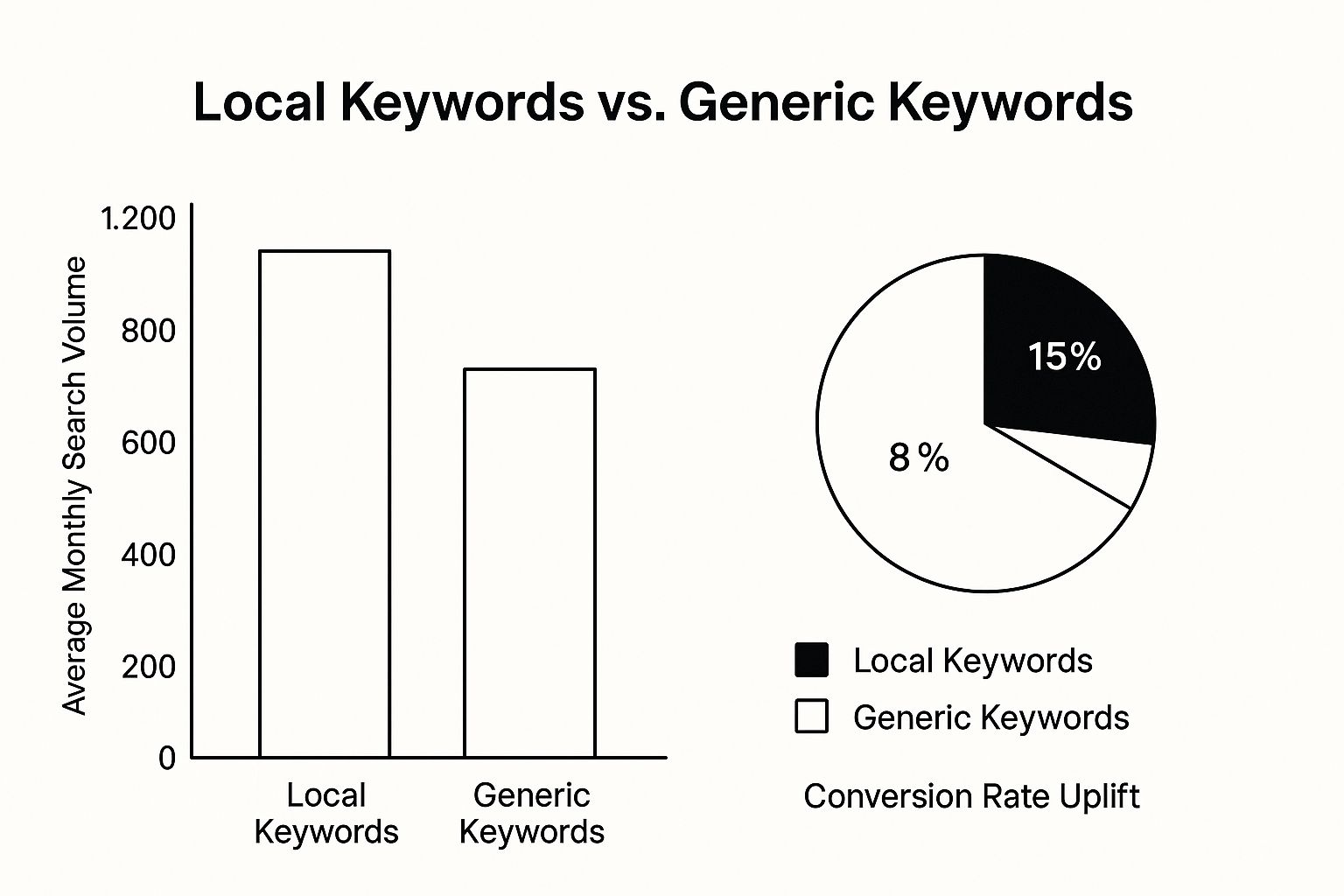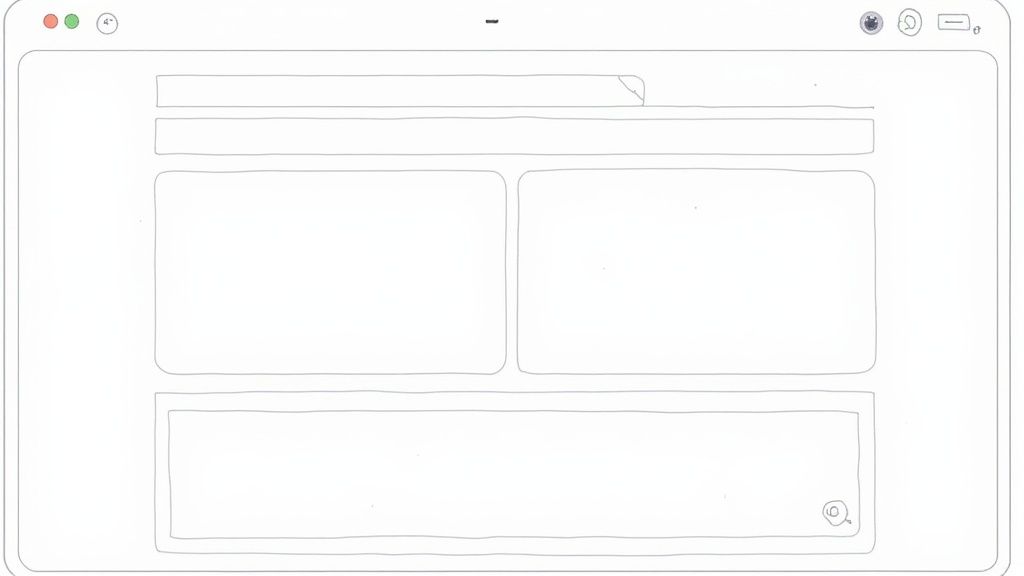In real estate, getting traffic to your website is one thing. Getting the right traffic is everything. If you want to connect with clients who are actually ready to make a move, you have to focus on local keywords that directly match buyer intent. This strategy cuts through the noise of casual browsers and puts you directly in front of serious buyers.
Why Local Buyer Intent Keywords Are a Game Changer
In a sea of real estate agents, the words people type into Google are your biggest clue to their intentions. Someone searching for “houses in Austin” is probably just starting out, maybe daydreaming a little. It’s a broad, low-intent search that casts a wide net but rarely catches a fish ready to be reeled in.
Now, consider a different search: “three-bedroom craftsman homes in Zilker elementary district.” That’s not a dreamer; that’s a buyer. They have a specific vision, a clear set of needs, and a much higher motivation to transact. These are the local keywords that directly match buyer intent, and they are absolute gold for agents. Targeting them means you stop chasing casual lookers and start attracting people who are deep into their home-buying journey.
From Broad Searches to High-Quality Leads
Shifting your SEO focus to these ultra-specific phrases transforms your entire lead generation process. You stop spending time and money on clicks from people who will never convert and instead draw in a smaller, but far more qualified, audience. It’s the classic quality over quantity play, and it works.
The real advantage here is efficiency. When you understand the language of ready-to-act buyers, you stop wasting resources on unqualified leads and focus your energy on people who are practically knocking on the door.
This approach does more than just bring in better leads; it positions you as a genuine local expert. When your website is the one providing detailed answers for niche searches about specific neighborhoods, school districts, or property types, you instantly build trust and authority. That’s a powerful competitive edge. You can enhance this expert status even further by sharpening your visual brand with some proven graphic design and social media tips.
To truly grasp the power of this approach, it helps to see the difference side-by-side.
High-Intent vs. Low-Intent Keyword Comparison
This table breaks down the contrast between the vague, informational searches most agents target and the specific, transactional keywords that drive real business.
| Keyword Type | Example Keyword | Likely Searcher Intent | Value to Agent |
|---|---|---|---|
| Low-Intent | “real estate Miami” | Early-stage research, browsing, not ready to act | Low; generates traffic but few qualified leads |
| High-Intent | “waterfront condos for sale in South Beach” | Specific interest, actively looking, ready to buy | High; attracts motivated buyers close to a deal |
| Low-Intent | “best family neighborhoods” | Informational, exploring options, comparing areas | Moderate; good for blog content, not direct leads |
| High-Intent | “4 bedroom homes for sale in Pinecrest schools” | Clear criteria, urgent need, transaction-focused | Very High; connects with serious, high-value clients |
As you can see, the more specific the search, the more valuable the lead. Targeting these high-intent phrases is the key to a more efficient and profitable online strategy.
The Power of Specificity in Conversions
The numbers don’t lie: specificity drives action. Long-tail keywords that align perfectly with a buyer’s checklist consistently outperform generic terms. For example, a search like “3-bedroom homes under $400,000 in Plano, Texas” can convert at a rate roughly 36% higher than a broad term like “Plano homes for sale.” Why? Because it’s an exact match for what the user wants.
This isn’t just theory. The data clearly illustrates the massive conversion lift you get from local, intent-driven keywords.

While broader keywords might bring in more eyeballs, the chart shows that local buyer-intent keywords are the ones that actually move the needle, delivering a much higher conversion uplift. That’s where you’ll find the real return on your marketing investment.
Uncovering Your Market’s Hyper-Local Keywords
If you want to connect with serious buyers, you have to learn to think like they search. That means digging deeper than just the city name. You need to get into the nitty-gritty, hyper-local terms that signal someone is ready to make a move. Honestly, the best keywords are usually right under your nose, hiding in the tools buyers are already using every day.
A great place to start is Google itself. Go to the search bar and type in a broad term like “homes for sale in Denver,” but don’t press enter just yet. Look at what Google Autocomplete suggests. You’ll likely see things like “homes for sale in Denver with mountain views” or “new construction homes in Denver.” These aren’t random phrases; they’re what real people are actively searching for. It’s a direct peek into what your local market wants.
Tapping into Real-World Search Behavior
Once you do hit enter, scroll down the results page to the “People Also Ask” (PAA) box. This section is an absolute goldmine for understanding the specific questions and pain points on a buyer’s mind. You’ll find questions like “what are the best family-friendly neighborhoods in Denver?” or “what is the average price per square foot in the Highlands?” Every single one of those questions is a long-tail keyword you can build an entire blog post or neighborhood page around.
It’s clear that searchers are getting more and more specific. In fact, research shows that a staggering 92.43% of Google searches are long-tail queries—phrases used 10 times or less each month. This points directly to how buyers are looking for homes, and you can learn more about adapting to this in this helpful real estate guide.
Beyond Standard Location Keywords
This is where you can really set yourself apart from the competition. Think about the unique quirks and features of your community that only a true local would know. This is how you demonstrate real expertise.
- School Districts: Don’t just mention schools. Target specific searches like “homes for sale in Cherry Creek School District” or even “Zillow homes for sale Northfield High School.” Parents search this way.
- Architectural Styles: Buyers often have a dream home in mind. Capture their attention with keywords like “mid-century modern homes in Englewood” or “Denver square homes for sale.”
- Unique Amenities: What’s the hot feature in your area right now? It could be anything from “homes with pickleball courts in Stapleton” to “houses with ADUs near Wash Park.”
- Local Lingo: Every city has its nicknames. Using a term like “homes in RiNo” instead of the more formal “River North Art District” instantly shows you’re an insider.
This screenshot gives a great visual of buyer-intent keywords that go way beyond simple city and state searches.
See how these examples include specific actions (“sell,” “buy”), property conditions (“foreclosed”), and types (“investment”)? That’s what signals clear intent from a user.
Pro Tip: I always recommend spending some time browsing your top competitors’ websites. Check out their community pages and see what their blog post titles are. Are they targeting hyper-local keywords you’ve overlooked? A little ethical snooping can quickly show you what’s working for them and where the gaps are in your own strategy.
Putting together a solid keyword list isn’t a five-minute job, but the results are more than worth the effort. When you move past generic terms, you align your website with the exact things motivated buyers are looking for. This approach is a critical piece of an effective local marketing strategy that helps turn website traffic into actual closings.
Weaving Buyer Keywords into Your Website Content
Having a brilliant keyword list is one thing; knowing how to use it is another. The real magic happens when you stop thinking about “stuffing” keywords and start focusing on weaving them into genuinely helpful content. The aim is to create resources so valuable that they naturally attract both search engines and, more importantly, motivated buyers. This is how you turn all that research into real-world results.
Your individual property listings are the front line. For many serious buyers, these pages are their first real interaction with you. So, instead of a dry, generic description, it’s time to enrich each listing with the hyper-local keywords you’ve uncovered. This means going far beyond the standard “3 bed, 2 bath” details.

Does the property have a “fenced yard perfect for dogs in the Green Valley Ranch area”? Is it “zoned for the highly-rated Pine Creek High School”? Call it out. Mentioning these specific details directly answers the long-tail questions that high-intent buyers are typing into Google every single day. You’re not just selling a house; you’re selling a perfect fit for their life.
Create Compelling Community Pages
While property listings are critical, your community pages are the secret weapon for capturing broader local traffic. Think of them as magnets for buyers who know where they want to live but haven’t picked a specific house yet. Your job is to become the go-to digital guide for that neighborhood.
Put yourself in their shoes. What does someone moving to the area really want to know? Your community pages should be packed with details that target keywords related to daily life.
- Local Amenities: Don’t just list amenities; bring them to life. Talk about the best local coffee shops, the playgrounds at “Memorial Park,” or the nearest grocery stores. A search for “homes near the Cottonwood Creek Trail” should land them squarely on your site.
- School Information: Go deeper than a simple list. Discuss school reputations, unique programs, and specific zoning boundaries. This is how you capture valuable searches like “top elementary schools in Briargate.”
- Lifestyle and Commute: What’s the commute like to the main employment hubs? Is the neighborhood walkable? Answering these practical questions builds incredible trust and establishes your authority from the get-go.
A well-crafted community page does more than just rank on Google—it establishes you as the undeniable local expert. When a buyer sees you’ve already answered all their questions about a neighborhood, you become their first and only call.
Answer Buyer Questions Through Your Blog
Your blog is the ideal place to answer the highly specific, question-based keywords that scream buyer intent. These are the queries people are searching for when they’re getting serious and weighing their options. Each blog post can become the definitive answer they’re looking for.
Try creating content based on these high-intent templates I’ve seen work time and time again:
- Tax and Cost Breakdowns: “What are the property taxes in the Rockrimmon neighborhood?”
- HOA Information: “A guide to HOA fees and rules in Cordera.”
- Comparative Analysis: “Old Colorado City vs. Manitou Springs: which is better for young families?”
When you create content that tackles these precise concerns, you’re doing more than just chasing local keywords that directly match buyer intent. You’re proactively solving problems for your future clients. It’s a powerful way to get ahead of the competition, attract qualified buyers straight to your website, and cement your reputation as the go-to agent in your market.
Optimizing for Voice and Mobile Home Searches
Let’s face it: the days of home buyers being tethered to a desktop computer are long gone. Today’s house hunt happens on the go. Buyers are using their phones to search for listings while driving through a neighborhood they love or asking their smart speaker a question over dinner.
This massive shift to mobile and voice search means your old keyword strategy needs a serious update. Stiff, formal keywords just don’t work when people are speaking naturally to their devices.
You have to start thinking in terms of full questions. Instead of just targeting a phrase like “pet-friendly condo Piedmont Park,” your content needs to answer the question a real buyer would ask: “Hey Google, find me a pet-friendly condo near Piedmont Park.”
The best way to do this? Structure some of your content, like blog posts or neighborhood guides, in a direct question-and-answer format. This makes it incredibly easy for voice assistants to grab your content and serve it up as the definitive answer.

It’s all about moving away from fragmented phrases and embracing the complete, natural-sounding queries that reflect how people actually talk.
Your Google Business Profile Is a Secret Weapon
When it comes to winning at mobile and voice search, your Google Business Profile (GBP) is one of the most powerful tools in your arsenal. It’s often the very first thing a potential client sees when they search “real estate agent near me.” Think of it as your digital storefront—it needs to be pristine to capture these high-intent local searches.
Your profile is a goldmine of information for both users and search engines. Keeping it accurate isn’t just a good idea; it’s essential.
- Perfect Your Contact Info: Your name, address, and phone number (NAP) have to be 100% consistent everywhere online. Even a small mistake can confuse Google and tank your local rankings.
- Use Google Posts Weekly: This feature is perfect for showing off new listings, announcing open houses, or sharing market updates. Every post sends a fresh signal to Google that your business is active and engaged in the community.
- Cultivate and Respond to Reviews: Reviews are a massive trust signal. Make a habit of asking happy clients to leave a review, and always take the time to respond thoughtfully. Better yet, those reviews often contain valuable local keywords that perfectly match buyer intent, giving you a natural SEO boost.
Your Google Business Profile is the ultimate mobile handshake. It gives a motivated buyer instant answers and directions, making it almost effortless for them to find you right from a map search.
Optimizing your GBP is a straightforward but incredibly effective way to dominate local mobile search results. It connects you directly with buyers at the exact moment they need you, turning a quick search on their phone into a direct lead. For any modern real estate SEO strategy, this isn’t optional—it’s how you capture on-the-go clients who are ready to make a move.
Measuring Your Success and Refining Your Strategy
Launching your local keyword strategy is a huge first step, but it’s really just the starting line. The real magic—and the competitive edge—comes from obsessively tracking your results and tweaking your approach based on what the data tells you. This is the feedback loop that separates a decent SEO effort from a true lead-generation machine. It’s how you stop guessing and start knowing what actually works.
To get this right, you’ll want to get comfortable with two free, powerhouse tools: Google Analytics and Google Search Console. I like to think of it this way: Search Console shows you what happens before someone clicks to your site, and Analytics tells you what they do after they arrive. Used together, they give you the full story.

What to Actually Pay Attention To
It’s easy to get lost in a sea of data. Don’t. You only need to focus on a handful of metrics that tell you if your strategy for targeting local keywords that directly match buyer intent is hitting the mark.
To keep things simple, here are the core metrics I always advise agents to monitor. They give you a clear, no-fluff picture of what’s working and what isn’t.
Key Metrics for Tracking Local SEO Success
| Metric | What It Measures | Tool to Use | Why It’s Important |
|---|---|---|---|
| Organic Traffic | The number of visitors landing on your site from unpaid search results. | Google Analytics | A rising number here is the clearest sign your overall visibility is growing. |
| Keyword Rankings | Where your website appears in search results for specific phrases. | Google Search Console | This directly tracks progress for your most valuable buyer-intent keywords. |
| Click-Through Rate (CTR) | The percentage of people who see your link in search results and actually click it. | Google Search Console | A high CTR tells you your headlines and descriptions are compelling enough to grab attention. |
| Conversion Rate | The percentage of visitors who take a key action, like filling out a contact form. | Google Analytics | This is the bottom line. It measures whether your traffic is turning into tangible business leads. |
Tracking these metrics consistently is the only way to truly understand the ROI of your efforts.
Your Monthly Strategy Check-In
Carve out some time every single month to sit down with this data. It’s non-negotiable.
Start in Google Search Console and head straight to the “Performance” report. You can see the exact search queries bringing people to your site. Are you seeing clicks from phrases like “homes for sale near Blevins Middle School”? If so, that’s your proof that the hyper-local approach is working.
Then, pop over to Google Analytics. Look at which of your community pages or blog posts are getting the most traffic and engagement. Let’s say your article on “property taxes in the Harmony Club neighborhood” is a hit traffic-wise, but no one is contacting you from it. That’s a sign your call-to-action is weak or poorly placed. On the flip side, if a particular neighborhood page converts like crazy, you’ve just found your blueprint. Go create more content just like it.
This isn’t about finding what you did wrong. It’s about discovering what you did right so you can pour fuel on that fire. Double down on what the data proves is working.
This constant refinement is what creates sustainable, long-term growth. It ensures every dollar and every minute you spend on marketing is pulling its weight and attracting the best possible leads. If you’re looking to better align your marketing spend with real results, it’s worth understanding the factors that influence marketing price ranges to see how you can invest for the strongest return.
By continuously analyzing and adapting, you’ll transform your website from a simple online brochure into a powerful business asset that consistently delivers.
Got Questions? We’ve Got Answers
Diving into local SEO always sparks a few questions. It’s completely normal. Here are some of the most common ones I hear from agents just starting to zero in on those powerful buyer-intent keywords.
How Many Local Keywords Can I Target On a Single Page?
This is a classic question, and the answer is to think in terms of topics, not just a list of keywords. Instead of trying to cram a bunch of different phrases onto one page, the best practice is to choose one primary keyword and then weave in two or three closely related secondary keywords.
Think of it this way: your goal is to create the most helpful, in-depth page about a single subject.
For example, if your main page is targeting “homes for sale in Northwood,” it’s completely natural to also mention terms like “Northwood elementary school homes” or “Northwood real estate listings.” This approach tells Google your page is a comprehensive resource for that specific area, making it much more likely to rank for a whole cluster of similar searches.
How Long Until I Actually See Results From This?
Here’s where you need to be patient. While a few quick wins can happen, a solid local SEO strategy generally takes about three to six months to start delivering significant, bankable results. It’s a marathon, not a sprint.
You’re essentially building trust and authority with search engines, and that takes time. They need to crawl, index, and understand your new and improved content before they start sending serious traffic your way.
Don’t get discouraged if you’re not an overnight success. The agents who win at this game are the ones who stick with it. My advice? Focus on optimizing your 5-10 most important pages first, then build from there.
Should I Focus on Making New Content or Just Update My Old Pages?
Honestly, you need to do both. This isn’t an either/or situation. A balanced approach gives you the best of both worlds—quick wins and long-term growth.
Start with a content audit to find your “low-hanging fruit.” Look for existing pages—maybe an old blog post or a thin community page—that are underperforming. Refreshing these with your newly researched local keywords that directly match buyer intent is often the fastest way to get a ranking bump.
At the same time, map out a content calendar for new articles and pages. This is your chance to target valuable keywords you don’t have any content for yet. You could create new neighborhood deep-dives or write blog posts answering specific questions like, “what are the average closing costs in Miami?”
This two-pronged strategy—updating the old while creating the new—is how you steadily build a website that becomes an authoritative magnet for motivated local buyers.
Ready to transform your real estate marketing with a data-driven strategy? The team at ReachLabs.ai integrates expert talent with powerful insights to deliver creative solutions that elevate your brand and generate qualified leads. Discover how our collective approach can help you dominate your local market. Learn more about our services.





